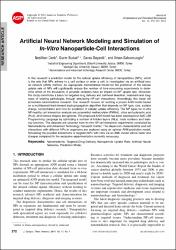| dc.contributor.author | Cenk, Neslihan | |
| dc.contributor.author | Budak, Gurer | |
| dc.contributor.author | Dayanik, Savas | |
| dc.contributor.author | Sabuncuoglu, Ihsan | |
| dc.date.accessioned | 2020-02-19T10:31:48Z | |
| dc.date.available | 2020-02-19T10:31:48Z | |
| dc.date.issued | 2014 | en_US |
| dc.identifier.issn | 1546-1955 | |
| dc.identifier.other | eISSN: 1546-1963 | |
| dc.identifier.other | DOI: 10.1166/jctn.2014.3348 | |
| dc.identifier.uri | https://hdl.handle.net/20.500.12573/182 | |
| dc.description.abstract | In this research a prediction model for the cellular uptake efficiency of nanoparticles (NPs), which is the rate that NPs adhere to a cell surface or enter a cell, is investigated via an artificial neural network (ANN) method. An appropriate mathematical model for the prediction of the cellular uptake rate of NPs will significantly reduce the number of time-consuming experiments to determine which of the thousands of possible variables have an impact on NP uptake rate. Moreover, this study constitutes a basis for targeted drug delivery and cell-level detection, treatment and diagnosis of existing pathologies through simulating NP-cell interactions. Accordingly, this study will accelerate nanomedicine research. Our research focuses on building a proper ANN model based on a multilayered feed-forward back-propagation algorithm that depends on NP type, size, surface charge, concentration and time for prediction of cellular uptake efficiency. The NP types for in-vitro NP-healthy cell interaction analysis are polymethyl methacrylate (PMMA), silica and polylactic acid (PLA), all of whose shapes are spheres. The proposed ANN model has been developed on MATLAB Programming Language by optimizing a number of hidden layers (HLs), node numbers and training functions. The datasets are obtained from in-vitro NP-cell interaction experiments conducted by Nanomedicine and Advanced Technology Research Center. The dispersion characteristics and cell interactions with different NPs in organisms are explored using an optimal ANN prediction model. Simulating the possible interactions of targeted NPs with cells via an ANN model will be faster and cheaper compared to the excessive experimentation currently necessary. | en_US |
| dc.language.iso | eng | en_US |
| dc.publisher | AMER SCIENTIFIC PUBLISHERS, 26650 THE OLD RD, STE 208, VALENCIA, CA 91381-0751 USA | en_US |
| dc.relation.ispartofseries | Volume: 11 Issue: 1 Pages: 272-282; | |
| dc.rights | info:eu-repo/semantics/openAccess | en_US |
| dc.subject | Prediction Model. | en_US |
| dc.subject | Artificial Neural Networks | en_US |
| dc.subject | Nanoparticle Uptake Rate | en_US |
| dc.subject | Nanomedicine | en_US |
| dc.subject | Targeted Drug Delivery | en_US |
| dc.title | Artificial Neural Network Modeling and Simulation of In-Vitro Nanoparticle-Cell Interactions | en_US |
| dc.type | article | en_US |
| dc.contributor.department | AGÜ, Mühendislik Fakültesi, Endüstri Mühendisliği Bölümü | en_US |
| dc.contributor.institutionauthor | | |
| dc.identifier.doi | 10.1166/jctn.2014.3348 | |
| dc.relation.publicationcategory | Makale - Uluslararası Hakemli Dergi - Kurum Öğretim Elemanı | en_US |


















